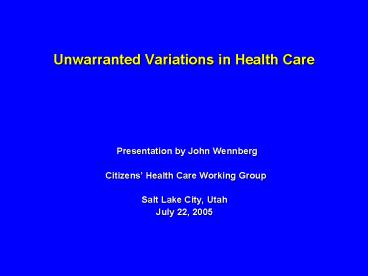Unwarranted Variations in Health Care - PowerPoint PPT Presentation
1 / 26
Title:
Unwarranted Variations in Health Care
Description:
The 3 Categories of Unwarranted Variations ... Failure to Provide Effective Care to Patient in Need is a Medical Error--An Error of Omission ... – PowerPoint PPT presentation
Number of Views:69
Avg rating:3.0/5.0
Title: Unwarranted Variations in Health Care
1
Unwarranted Variations in Health Care
- Presentation by John Wennberg
- Citizens Health Care Working Group
- Salt Lake City, Utah
- July 22, 2005
2
The 3 Categories of Unwarranted Variations
Variation not explained by illness, patient
preference or medical evidence
3
Effective Care Refers to
- Services of Proven Effectiveness
- Services that involve no significant
tradeoffs--all with specific needs should receive
them - Failure to Provide Effective Care to Patient in
Need is a Medical Error--An Error of Omission
4
There is Extensive Underuse of Effective Care
Throughout the United States Diabetic Medicare
Enrollees Annual Eye Exam (1999-2000) (Each
dot represents one of the 306 regions.)
5
Patient Safety / Failure of effective care
among regions Major leg amputation/1000
(1998-2001)
Non-Black Males
Black Males
Non-Black Females
Black Females
6
Shape of the Benefit-Utilization CurveEffective
Care Patient Safety
U.S. is
some-
where
in this
zone
Benefit to Patients
7
Reducing underuse of effective care
- Major focus improving provider performance
through data feed back, infra-structure building
and paying for performance
8
Preference-Sensitive Care
- Involves Tradeoffs--More than one treatment
exists and the outcomes are different - Evidence sometimes good, sometimes not
- Decisions should be based on the Patients Own
Preferences - But Provider Opinion Often Determines Which
Treatment is Used
9
Pattern of Variation and SCV for Hip Fracture,
Hip and Knee Replacement and Back Surgery
(2000-01)
10
Surgical Signatures for Three Florida Regions
11
Relationship Between Supply of Orthopedic
Surgeons (1999) and Knee Replacement Rates
(2000-01)
12
Relationship Between Knee Replacement Rates in
1992-93 and 2000-01
13
Shape of the Benefit-Utilization
CurvePreference-Sensitive Care (e.g. Surgery)
14
Reducing misuse for preference-sensitive care
Information therapy is essential
- Major focus shared decision making
15
(No Transcript)
16
The BPH Treatment DecisionWhat is at Stake for
the Patient?
- Tradeoff between urinary tract and sexual
function - Degree of bother versus objective level of
symptoms - Traditional tests of urinary tract function dont
correlate with symptom level - Learning which rate is right depends on sorting
this all out at the micro-level of the
doctor-patient relationship
17
Impact of improved decision quality on surgery
rates BPH
18
of BPH Patients Choosing Surgery under Shared
Decision Making by Symptom Level
19
Impact of improved decision quality on surgery
rates CHD
Knowledge of relevant treatment options and
outcomes
Concordance between patient values and care
received
Toronto trial
20
Reducing misuse for preference-sensitive care
Information therapy is essential
- Major focus shared decision making
- New focus report cards measuring decision
quality
21
(No Transcript)
22
Reducing misuse for preference-sensitive care
Information therapy is essential
- Major focus shared decision making
- New focus report cards measuring decision
quality - Traditional provider-focused appropriateness
guidelines dont work
23
Reducing misuse for preference-sensitive care
Information therapy is essential
- Major focus shared decision making
- New focus report cards measuring decision
quality - Traditional provider-focused appropriateness
guidelines dont work - Major impediment adverse economic incentives
24
Supply-Sensitive Care
- The frequency of use is governed by the
assumption that resources should be fully
utilized, i.e. that more is better - Specific medical theories and medical evidence
play little role in governing frequency of use - In the absence of evidence and under the
assumption that more is better, available supply
governs frequency of use
25
Association between hospital beds per 1,000 and
discharges per 1,000 among Medicare Enrollees
306 Hospital Regions
26
Association between cardiologists and visits per
person among Medicare Enrollees 306 Regions
(Under the More is Better Assumption, Capacity
Determines Need)































